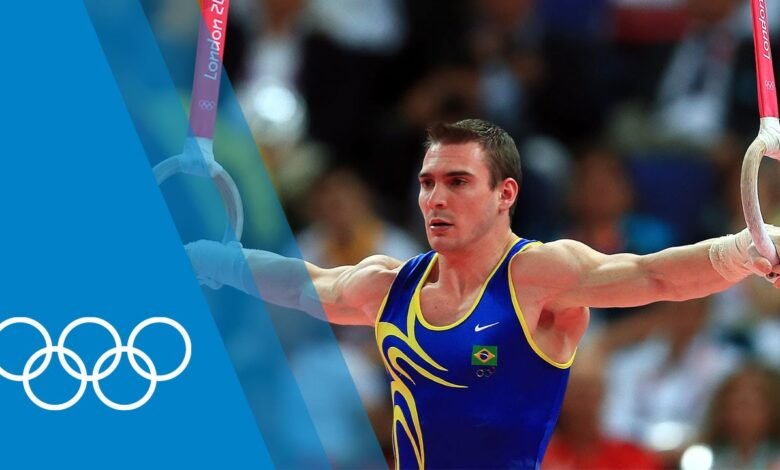Gymnastics Rings Olympics: The Ultimate Guide to the Olympic Sport

Introduction to Gymnastics Rings
Gymnastics Rings Olympics are a pivotal element in the world of gymnastics, recognized for their distinctive challenges and the exceptional skill set required to master them. Originating from ancient cultures, rings have evolved to become a staple apparatus in competitive gymnastics, most notably within the Olympic arena. They present a test of strength, balance, and agility, making them a respected event among both athletes and spectators.
The history of gymnastics rings can be traced back to the early 19th century when they were first introduced as part of the gymnastics programs in Europe. Initially utilized for both artistic expression and strength training, their importance grew as the sport progressed. The introduction of rings into the Olympics marked a significant milestone, showcasing athletes’ acrobatic abilities and raw power. Today, they are a highlight of the artistic gymnastics events, captivating audiences with their dramatic displays of strength and elegance.
Competing on gymnastics rings involves executing a variety of complex movements such as the iron cross, muscle-ups, and various holds, all of which require extraordinary upper body strength and control. The ring’s unique design allows athletes to perform intricate routines that emphasize body tension and core stability. To successfully navigate these movements, gymnasts must undergo rigorous training, focusing on not only strength but also flexibility and coordination.
Beyond their physical demands, gymnastics rings symbolize the dedication and perseverance of athletes. The intense preparation and discipline required to excel in this event reflect the broader ethos of gymnastics as a whole. As we delve deeper into the gymnastics rings Olympics, it becomes clear that this apparatus is not merely a tool for performance but an embodiment of athletic artistry and rigorous competition.
The Importance of Gymnastics Rings in the Olympics
Gymnastics rings have long been considered one of the most prestigious and demanding events in the gymnastics discipline, especially at the Olympic level. They uniquely combine strength, balance, and grace, highlighting the extraordinary athleticism of the competitors. The ability to perform complex, physically taxing maneuvers while maintaining perfect form and control is a hallmark of this event, making it a true test of both mental and physical fortitude.
One of the key reasons gymnastics rings hold such significant importance in the Olympics is their representation of pure strength. Unlike other gymnastic apparatuses, the rings do not rely on springs or momentum; instead, athletes must depend solely on their upper body strength to execute moves such as the iron cross and the planche. This emphasis on strength builds a captivating narrative around the event, drawing spectators who appreciate the raw power and dedication that elite gymnasts exhibit in their performances. The difficulty level of routines performed on the rings dictates the caliber of competition and often results in thrilling displays of athleticism that resonate with fans worldwide.
Moreover, the rings event is emblematic of the artistry inherent in gymnastics. Judges assess not only the difficulty of the routines but also the execution and overall aesthetic appeal. This dual focus on both strength and artistic presentation allows athletes to showcase their individuality and creativity within a rigid framework. The scoring system rewards not just technical prowess but also the graceful execution of movements, making it an essential component of the gymnastics competition. As a result, gymnastics rings stand as a symbol of excellence at the Olympics, signifying the fusion of power and finesse in the realm of elite sports.
Rules and Regulations of Olympic Rings Competition
The gymnastics rings event at the Olympics is governed by a comprehensive set of rules and regulations established by the International Gymnastics Federation (FIG). Adherence to these standards ensures a level playing field and maintains the integrity of the competition. Competitors in this discipline must demonstrate their strength, control, and artistry during their routines, which are typically performed on wooden rings suspended from a frame.
One of the primary components of evaluation is the judging criteria, which consist of several key factors. Judges assess the execution of the routine, including the precision of movements and the fluidity of transitions. A significant aspect of the scoring system is the Difficulty Score (D Score), which reflects the complexity of the elements performed. Gymnasts must incorporate a combination of strength holds, swings, and static holds to optimize their D Scores. The Difficulty Score is calculated based on the elements included in the gymnast’s routine; thus, the more complex the moves, the higher the potential score. This scoring approach ensures that gymnasts push their limits while performing on gymnastics rings for the Olympics.
Moreover, the Execution Score (E Score) is equally vital in determining a gymnast’s overall performance. Judges assign deductions for any noticeable errors in technique, such as lack of balance, form, or stability. The cumulative score is ultimately a balance between the D Score and E Score, which incentivizes athletes to not only aim for high difficulty but also maintain impeccable execution. Failure to adhere to any of the stipulated rules can result in significant score deductions, further emphasizing the importance of following international standards throughout the competition. This careful balance of strength, skill, and adherence to guidelines is what makes the gymnastics rings event one of the more captivating demonstrations of athletic prowess in the Gymnastics Rings Olympics.
Training Techniques for Success on Gymnastics Rings
Training on gymnastics rings requires a multifaceted approach that emphasizes strength, flexibility, and specific skill drills tailored to elevate performance to an Olympic level. First and foremost, strength building is essential. Gymnasts need to develop upper body and core strength to control their bodies effectively while maneuvering through various positions on the rings. Exercises such as pull-ups, dips, and muscle-ups can significantly enhance the necessary muscle groups. By incorporating resistance training and progressive overload, athletes can build the explosive strength required for stunts performed during the gymnastics rings events at the Olympics.
Flexibility cannot be overlooked in this rigorous training regimen. Good flexibility allows gymnasts to achieve optimal form during their routines, resulting in improved execution of movements. Stretching routines should focus not only on general flexibility but also on specific areas such as shoulders, hips, and wrists, which are critical for ring-related skills. Dynamic stretches and mobility drills can also be incorporated into the training sessions to ensure that the athletes maintain a full range of motion essential for performing complex maneuvers on the rings.
In addition to strength and flexibility, gymnasts should engage in targeted drills that focus on the unique elements of gymnastics rings. Drills such as the L-sit, skin the cat, and ring swings are crucial to building the specific skills necessary for Olympic competition. These drills foster a sense of balance, coordination, and body awareness, which are vital for executing high-level routines. Implementing a consistent schedule that includes these elements will ensure that athletes not only prepare physically but also mentally for the challenges they will face at the prestigious gymnastics rings events during the Olympics.
Notable Olympic Gymnasts and Their Rings Performances
The gymnastics rings event has long been a highlight of the Olympic Games, showcasing unparalleled strength, flexibility, and artistry. Several notable gymnasts have left an indelible mark on this discipline through extraordinary performances. One such figure is the legendary Russian gymnast Aleksandr Dityatin, who competed at the 1980 Moscow Olympics. Dityatin’s rings routine was characterized by exceptional control and fluid transitions, helping him secure a brilliant medal tally, including a gold medal on the rings. His performance is often remembered for its technical precision and difficulty, setting a standard for future athletes in this event.
Another noteworthy gymnast is the American legend, Paul Hamm. At the 2004 Athens Olympics, Hamm delivered a breathtaking rings routine that was integral to his all-around victory. His ability to combine dynamic strength elements with graceful movements captured the attention of spectators and judges alike, elevating the rings event to new heights in terms of athletic excellence. Hamm’s performance reflected the rigorous training and dedication required to excel in gymnastics rings at this prestigious level.
In more recent Olympic history, we have seen the rise of athletes like Arthur Nory, representing Brazil. At the 2016 Rio Olympics, Nory dazzled the audience with his inventive style and commanding presence on the rings. His performance was noted for its unique combinations and artistic flair, which resonated with emerging gymnasts aspiring to follow in his footsteps. The Olympics have been a platform for gymnasts like Nory to push boundaries and redefine what is possible in the rings event.
These athletes exemplify the spirit and skill required to succeed in the challenging gymnastics rings discipline at the Olympics. Their exemplary performances have inspired generations of gymnasts, ensuring that the legacy of this event endures for years to come.
Technological Advancements in Gymnastics Rings Equipment
The evolution of gymnastics rings equipment has significantly transformed the landscape of the sport, particularly in the context of the Olympics. Modern advancements have introduced high-quality materials that enhance not only the durability of the rings but also the performance standards of athletes. Traditionally made from wood, contemporary gymnastics rings are more frequently constructed using a combination of synthetic materials and advanced polymers that provide superior grip and responsiveness during routines. These materials ensure that athletes can perform intricate maneuvers with greater ease, reducing the risk of equipment failure during competition.
Additionally, the introduction of safety features has played a crucial role in improving training conditions. The use of reinforced straps and advanced adjustable systems enhances the stability of the rings, allowing gymnasts to focus on their technique rather than equipment reliability. This focus on safety has resulted in a greater emphasis on more complex routines being performed, as athletes feel more secure pushing the boundaries of their abilities. This has been reflected in heightened competitive performances in the gymnastics rings event at the Olympics.
Another critical advancement is the integration of data analytics tools, which provide live feedback on an athlete’s performance during training. This technology allows coaches to analyze movements and make real-time adjustments to improve skills before competition. By utilizing these technological innovations, gymnasts can refine their routines to align with Olympic standards, achieving both aesthetic excellence and technical precision required at the highest levels of the sport.
As gymnastics continues to evolve, the advancements in equipment and technology will undoubtedly play a pivotal role in shaping future performances. These improvements not only contribute to individual athlete success but also elevate the caliber of gymnastics rings events on the Olympic stage, attracting more viewers and inspiring the next generation of gymnasts.
The Role of Coaches in Preparing Gymnasts for Olympic Rings
Coaches play an indispensable role in the development and preparation of gymnasts competing on the Olympic rings. As the central figures in an athlete’s training regimen, coaches are responsible for designing programs that not only enhance physical strength but also refine technical skills specific to the gymnastics rings. This intricate piece of equipment requires proficiency in balance, control, and explosive power, and coaches must create training plans that target these areas effectively.
Beyond physical preparation, coaches also engage in mentorship that encompasses the overall well-being of the gymnast. This involves fostering a supportive environment where athletes feel encouraged to express their thoughts and emotions about their training experiences. Due to the immense pressure associated with competing at the Olympic level, this aspect of coaching is essential. Coaches help athletes develop coping mechanisms to tackle stress and anxiety associated with competition, ultimately aiming to improve performance during critical moments.
Moreover, effective coaches instill a growth mindset in their gymnasts. This philosophy encourages athletes to embrace challenges and view failures as opportunities for learning. In the context of gymnastics rings, where precision and skill execution are vital, having a resilient mindset can significantly influence an athlete’s performance. Coaches facilitate this psychological preparation through various techniques, including visualization exercises and performance simulations, which help prepare athletes for the unpredictable nature of competition.
In addition, the coach-gymnast relationship is crucial; trust and communication form the backbone of effective training. A coach who understands their athlete’s strengths and weaknesses can tailor their coaching style to assist the gymnast in mastering the complexities of the rings. Therefore, as gymnastics rings gain visibility in the Olympics, the pivotal role of coaches becomes more significant, emphasizing their impact on gymnasts’ journeys toward Olympic success.
Future Trends in Olympic Gymnastics Rings
As the landscape of competitive sports evolves, so too does Olympic gymnastics, particularly in the domain of gymnastics rings. One of the most noteworthy trends is the potential reformation of scoring systems. Currently, scoring in gymnastics rings is reliant on a combination of difficulty and execution. However, there is a growing push towards implementing a more nuanced scoring method that incorporates technology, such as digital scoring systems that utilize video analysis for precision judging. This could help provide a more transparent scoring process, ensuring fairness and accuracy for all competitors.
Moreover, new training methodologies are emerging that aim to enhance athletes’ performance. With advancements in sports science, training regimens are becoming increasingly sophisticated. Coaches are beginning to integrate data analytics into their training programs, allowing for personalized adjustments based on athletes’ strengths and weaknesses. This shift towards individualized coaching may significantly impact how gymnasts prepare for the Olympics, potentially leading to higher performance levels on the gymnastics rings.
Additionally, the sport may see an increase in the variety of skills performed on gymnastics rings. As athletes continue to push the boundaries of their capabilities, we can expect more complex routines that showcase strength, flexibility, and artistry. Innovations in training techniques, combined with a focus on injury prevention and recovery, will likely influence the skillset required for success in future Olympic competitions.
Ultimately, the evolution of gymnastics rings in the Olympic context may reflect broader trends in sports, including increased athlete specialization and the integration of technology. As these changes take root, they promise to reshape not only the competition but also the experience for athletes and fans alike, potentially redefining what it means to excel in gymnastics rings at the Olympic Games.
Conclusion and Final Thoughts on Gymnastics Rings in the Olympics
The gymnastics rings have become a significant event within the Olympic framework, showcasing the incredible strength, flexibility, and artistry of athletes worldwide. Throughout this guide, we have explored the history, technical aspects, and competitive strategies associated with gymnastics rings at the Olympics. These rings not only test the physical prowess of gymnasts but also serve as a stage for their creative expressions, embodying the spirit of the Olympic Games.
As we reflect on the evolution of gymnastics rings in the Olympics, it is clear that this event has garnered an enthusiastic following, both in terms of viewership and participation. This interest is evidenced by the increase in training programs designed to develop young athletes, alongside enhanced coaching methods aimed at nurturing their talents. Moreover, the potential for innovative routines and the introduction of new skills continues to raise the bar for competition standards in the sport.
The importance of gymnastics rings in the Olympic community cannot be overstated. They represent not only an athletic challenge but also a symbolic gesture of dedication and discipline. As the sport progresses, we can expect to see advancements in equipment and technique, further pushing the boundaries of what is possible within this discipline. Indeed, the gymnastics rings will likely remain a staple of the Olympic Games, captivating audiences with both thrilling performances and inspiring stories of resilience and achievement.
In summary, as gymnastics rings continue to hold a place of honor in the Olympics, they symbolize the increasing recognition of this demanding sport. With growing support, we can anticipate its ongoing success and development for future generations of gymnasts around the globe. The journey of gymnastics rings will undoubtedly unfold with exciting developments as athletes seek to conquer new heights in their Olympic pursuits.
You May Also Read This Shsolution.



